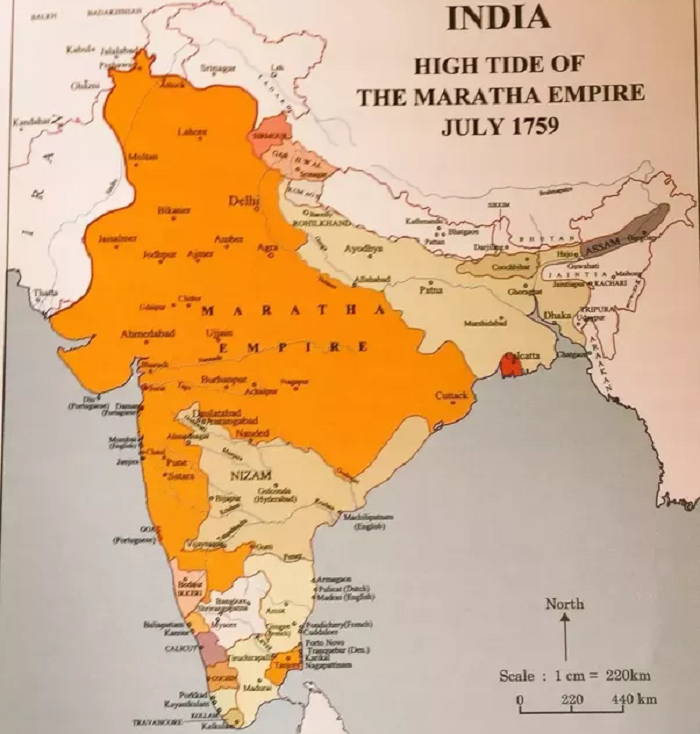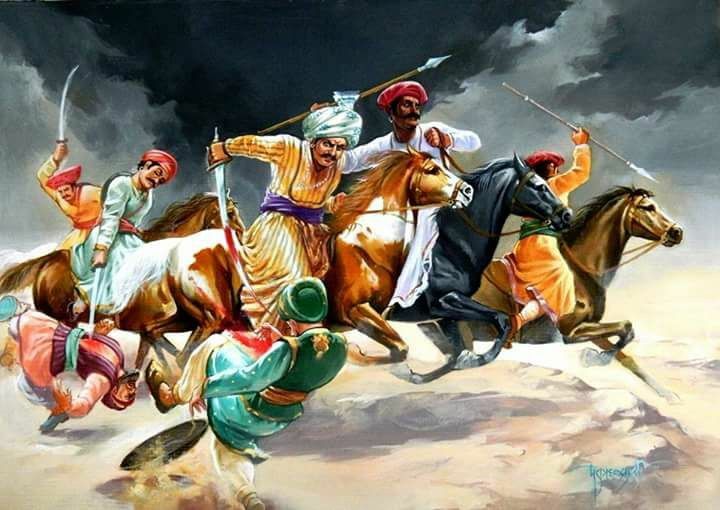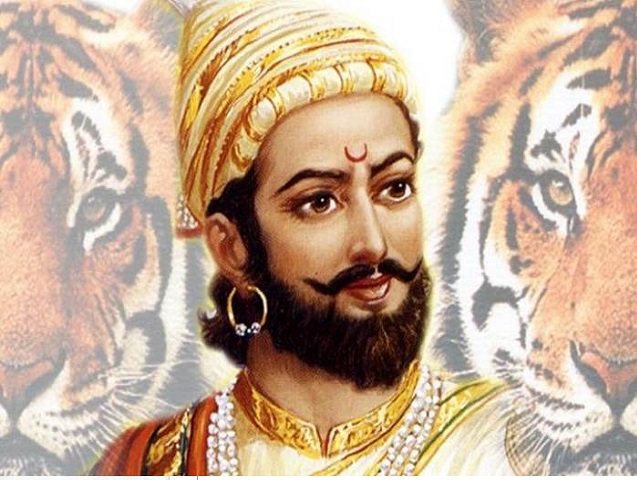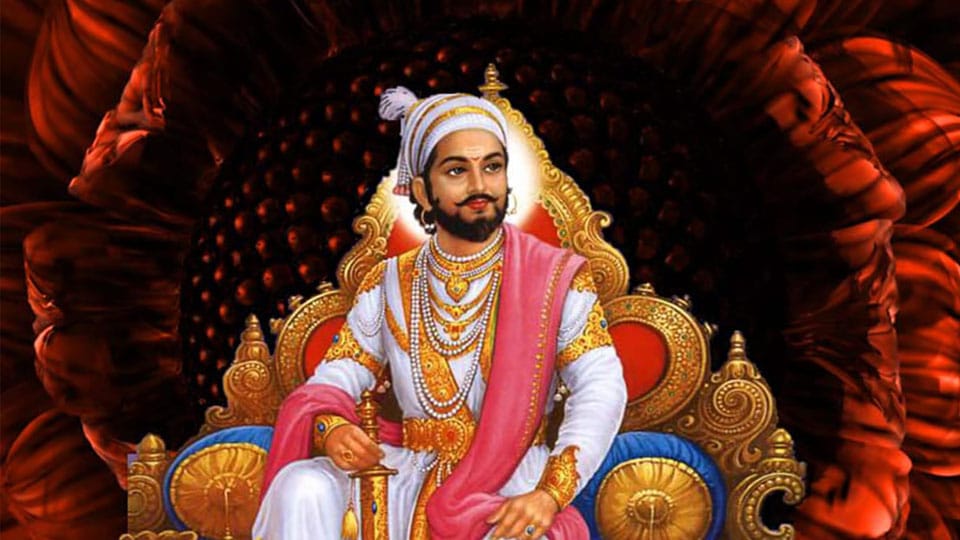There is no doubt that the single most important power to emerge in the long twilight of the Mughal dynasty was the Maratha confederacy. Initially deriving from the western Deccan, the Marathas were a peasant warrior group that rose to prominence during the rule in that region of the sultans of Bijapur and Ahmadnagar. The most important Maratha warrior clan, the Bhonsles, had held extensive jagirs (land-tax entitlements) under the ʿAdil Shahi rulers, and these were consolidated in the course of the 1630s and ’40s, as Bijapur expanded to the south and southwest.

Shahji Bhonsle, the first prominent member of the clan, drew substantial revenues from the Karnataka region, in territories that had once been controlled by the rulers of Mysore and other chiefs who derived from the collapsing Vijayanagar kingdom. One of his children, Shivaji Bhonsle, emerged as the most powerful figure in the clan to the west, while Vyamkoji, half-brother of Shivaji, was able to gain control over the Kaveri (Cauvery) River delta and the kingdom of Thanjavur in the 1670s.
Shivaji’s early successes were built on a complex relationship of mixed negotiation and conflict with the ʿAdil Shahi on the one hand and the Mughals on the other. His raids brought him considerable returns and were directed not merely at agrarian resources but also at trade. In 1664 he mounted a celebrated raid on the Gujarat port city of Surat, at that time the most important of the ports under Mughal control.
The next year he signed a treaty with the Mughals, but this soon broke down after a disastrous visit by the Maratha leader to Aurangzeb’s court in Agra. Between 1670 and the end of his life (1680), Shivaji devoted his time to a wide-ranging set of expeditions, extending from Thanjavur in the southeast to Khandesh and Berar in the north. This was a portent of things to come, for the mobility of the Marathas was to become legendary in the 18th century.
Nature of Rising of Maratha

A section of historian comprising scholar Sir J. Sarkar emphasized that Maratha Movement was a national movement & Shivaji was a national leader. Supporters of this emphasized that Marathas under Shivaji had inspired vision & their fight against Mughal reflected the same.
Closer examining the idea, which inspired the Maratha Movement & object of Maratha leaders doesn’t reveal any Pan India nationalism. Marathas fought for their own Independence & pan India nationalism was absent. Fight against Mughal couldn’t be accepted as nationalist struggle cause the middle of the 17th century; Mughals were no longer foreign.
Nationalism in a foreign sense was a much later phenomenon in Indian history. It emerged only in the latter half of the 18th century. The Marathas didn’t make any serious efforts to win over the support of other groups to create a nation. Their relation with others was hostile. At the most Maratha Movement was accepted as Maratha Nationalism but was difficult to accept as Indian nationalism.
Was Maratha Movement a Hindu Movement?
A section of historian emphasized that Shivaji was inspired by the idea of “Hindu Rashtra”. This view was put forward based on titles adopted by Shivaji like “Hindutva Dharma Udharak”, “Go brahmana pratipalak” etc. Closer examination of Maharaja Shivaji & the character of his policy clearly reveals that he was a secular political leader, not a Hindu leader as such. The title adopted by Shivaji was the common title of age. These titles adopted by Rajput as closely associated with Mughal.
Maratha state was a secular state, no religious discrimination was practiced both Hindu & Muslim enjoyed the freedom to practice their faith in the manner they desire. Shivaji recruited both Hindu & Muslim soldiers in the army. In c.1656 CE, a separate Pathan unit was created by him. His naval chief was Muslim.
Shivaji’s fight against Aurangzeb was not a religious war but it’s a purely political character that both were inspired by the idea of established political dominance over Deccan. He had allied himself with Muslim rulers of Vijapur against Hindu Nayaka in Karnataka.
Was Maratha Movement a reaction against Aurangzeb?
A section of historians believes that it was the policy of Aurangzeb that triggered the rise of the Maratha Movement when Aurangzeb tried to establish his effective direct rule over Deccan; the Marathas emerged as a political force.
Closer examination of the history of the Maratha Movement reveals that the early phase of the rising of Maratha was during the reign of Shahjahan.
The fort of Purander was conquered by Shivaji in 1648. His 1st major achievement was in 1648 in the conquest of the fort of Torana.
By the time Aurangzeb emerged in the scene in 1658, Marathas were a force to reckon with. The heightened behavior of the Aurangzeb intensified Maratha Movement.
Factors involved in the rising of the Maratha Movement
The rise of Maratha as political power around the middle of the 17th century was one of the most significant developments in the history of India because at one time it appeared as if Maratha would successfully replace mighty Maratha.
The emergence of Marathas as a political force was the outcome of the combined effect of several factors that acted together. Among these factors, the role of Maharashtra Dharma contribution of Deccan State, the leadership of Shivaji.
Role of Geography in rising of Maratha Movement

The Maratha land was geographically isolated; as a result, a type of culture could emerge. The Maratha forget the bonds of unity among them & gradually they could emerge as the dominant force.
Their region was deficient in natural resources; most of it was falling in the rain shadow zone. As a result, Marathas had to work very hard to day to day living. This daily hardship imparted Marathas were a great strength of character. This hardy character of Marathas contributed greatly to their success against mighty Mughals.
The economic region was underdeveloped as a result economic condition of most Maratha was seen. Sharp economic divisions were absent among people. This uniformity was another reason for unity among them. The region was a hilly area. It was very difficult for outsiders to understand local topography because this Marathas could use the Guerilla method of warfare with great effectiveness. This indirect method of warfare enabled Maratha to challenge mighty Mughals successfully.
Marathas were living a life of Independence for ages. The spirit of Independence was very powerful among Maratha cause of this Aurangzeb tried to establish the direct rule of Maratha land, a furious reaction emerged in the form of Maratha movements.
Role of Maharashtra Dharma
Maharashtra Dharma refers to a branch of Bhakti Movement that emerged in Maratha land, saint viz, Namdev, Tukaram, Dyaneshwar, Ramdas propagated the message of Bhakti among Marathas. The Maharashtra Dharma emphasized on social equality, evils like caste & untouchability were condemned.

They infused great energy among Marathas propagating liberal & progressive ideas. Spirit of scarifying for the cause of motherland was uncultivated among Maratha. A sense of pride is also infused among masses towards Maratha culture. Efforts made by saints of Maharashtra Dharma gave new hopes & aspirations to Marathas.
Marathas were already looking for a strong identity when Shivaji emerged in the scene. Maharashtra Dharma prepared the strong socio-cultural background for the emergence of political in Maratha land inspired by the idea of Independence & Maratha identity.
Role of Deccani State
Deccani state Vijapur, Ahmadnagar contributed significance both directly and indirectly to the rise of Marathas as a political force. The early Maratha commanders such as Shahaji Bhosale worked with Ahmednagar state. Here they got training in admin & military. This knowledge & experience were used by Marathas later to create a strong empire.
Administrative institute & practices of Maratha state such as institution as Asthapradhan was adopted from Deccani state. The Shivaji Land revenue system was based on the revenue system developed by Amer Malik of Ahmednagar. Guerilla method of warfare also adopted from these Deccani state Amer Malik progenitors of this form of struggle.
Role of Shivaji

Shivaji was the leader & founder of the Maratha Movement. When he emerged in the scene in 1640, a larger background was already there for the political rise of Marathas. Through his phenomenal leadership, Shivaji brought the shattered Maratha elements to a common platform.
He raised a strong Maratha army. His military success gave hopes to Marathas that their dream of a Maratha nation could be realized. The Foundation of the Maratha kingdom in the 16th century was a great inspiration for Maratha & now they could fight for their safety & make it stronger.

